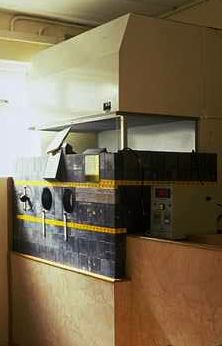Radiopharmaceuticals
Radio-pharmaceuticals are drugs that contain one or more radioactive isotopes. During their production, transport and use they need to be treated like any other open emitter, but also general principles of working with a drug need to be adhered to.
A radio nuclide that is used to create a radiopharmaceutical has several characteristics that are essential during treatment/examination. Several of these are:
- half-life of the radionuclide and its activity during application and observation of the drug
- radiation energy
- type of radiation
Carrier, a molecule that binds itself to the radionuclide, determines the localisation and bio-distribution in different parts of the body. There are many different types of carriers and the frequency of their use varies greatly. It depends on their side-effects and cost, availability and the performance of the tests done with that particular molecule. Recently, radio-pharmacology has been on the rise, mainly due to the introduction of specific monoclonal antibodies.
Radio-pharmaceuticals for general use are delivered in the so-called kits, which include a radionuclide generator and an unlabelled pharmaceutical in its required form. The labelling itself takes place right before the administration of the radiopharmaceutical.
Preparation of radio-pharmaceuticals[edit | edit source]
The preparation of the radiopharmaceutical is carried out in four steps:
1. obtaining the radionuclide
2. preparation and labelling of the substance
3. production of the desired dosage form
4. control
Obtaining the radionuclide[edit | edit source]
Today, only artificially prepared radionuclides are used in which very high purity is ensured.
These may be prepared in:
- radionuclide generators by the breakdown of the parental radionuclide
- particle accelerators by the impact of particles on the "source element" target
- nuclear reactors by the separation from fusion products
Preparation and labeling[edit | edit source]
The labeling of substances utilises the fact that radionuclides behave chemically in the same way as non-radioactive isotopes.
Isotope exchange reactions utilise the exchange of atoms of stable isotopes in a molecule of a substance for an unstable radionuclide. This procedure is mainly used for substances labeled with iodine radionuclides.
Chemical synthesis is a method in which substances are produced by a known chemical method, but some reactants are replaced with radioactive nuclides or previously labeled substances. The various conditions under which the reaction proceeds can affect the position of the radionuclide within the molecule. This method is used for production of e.g. 18F-fluorodeoxyglucose (FDG), compounds of radioactive carbon 11C and 14C. Chelates are prepared similarly wherein the radionuclide is attached by a coordination-covalent bond (e.g., labeled EDTA, DTPA).
Biochemical and enzymatic syntheses introduce radionuclides into the molecules through enzymatic processes.
Production of dosage form[edit | edit source]
The final dosage form of the radiopharmaceutical for administration is created similarly to non-radioactive drugs. The preparation technology itself differs due to the necessity of following all regulations for working with radioactive emitters.
Quality control[edit | edit source]
Radio-pharmaceuticals are subject to the same quality requirements as other pharmaceuticals. We evaluate physical, chemical and biological properties.
Determination of radioactivity is very important for the use of a radiopharmaceutical. It is necessary to know its value before administration; both for reasons of the radiation load (exposure) and for the objective assessment of the examination.
The radiochemical purity of a radionuclide is not always uncompromised. The contamination of a radionuclide is caused by isotopes formed during the production of the radionuclide. For the most part these are other radionuclides of the same element. Radiochemical contamination indicates the ratio of drug activity to other substances in the final dosage form.
Biological purity is a closely monitored parameter in parenterally administered radio-pharmaceuticals. The end product must be pyrogen-free, sterile and as little toxic as possible.
Pharmaceutical forms[edit | edit source]
The resulting pharmaceutical form depends on the examination or the therapy in which the pharmaceutical will be used. Radio-pharmaceuticals can be produced in all physical states and their combinations (emulsion, mist, etc.).
- Parenteral radio-pharmaceuticals are the clinically most used form. We distinguish homogenous solutions, colloids (labelled using albumin) and suspensions. Usually they are administered intravenously, although it is also possible to apply the drug subcutaneously or intralumbary. Radio-pharmaceuticals in α-emitter radiopharmaceutical therapy are injected into body cavities (intraperitoneally, intraarticularly).
- Oral radio-pharmaceuticals are usually administered as aqueous solutions or gelatine capsules. Food labelled with radionuclides (goulash, fried eggs, etc.) is used for the gastrointestinal motility examination.
- Inhalation radio-pharmaceuticals consist either of radioactive gases (81mKr) or mists of an aqueous solution obtained from ultrasonic wave nebulizers or jet nebulizers (usually substances labelled using 99mTc).
- Topically applied radio-pharmaceuticals are used especially for targeted tumour therapy.
Uses in medicine[edit | edit source]
Radio-pharmaceuticals can be used for diagnostics or therapy.
Diagnostic radio-pharmaceuticals[edit | edit source]
Radio-pharmaceuticals labelled using pure and non-pure positron emitters (99mTc, 67Ga, 131I, etc.) are necessary for scintigraphy.
Labelling radio-pharmaceuticals with β+ emitters is needed for PET examination. These are emitting positrons that then annihilate. The most used radio-pharmaceutical is 18F-FDG, although carbon isotopes (11C), oxygen isotopes and nitrogen isotopes might be used as well.
Therapeutic radio-pharmaceuticals[edit | edit source]
Therapeutic radio-pharmaceuticals are used for emitter insertion into the treated lesions, usually tumours. Their specificity must be the highest possible in order to prevent damage to other structures that could also bind the radio-pharmaceuticals. The chosen radionuclides are β-emitters characterised by short-range impact (no more than a few millimetres) with a higher radiation energy. The tissue which is affected by a radio-pharmaceutical is exposed to a high amount of radiation which then leads to the formation of radicals that damage cell structures. The damaged cells then either die or are incapable of further cell division.
Links[edit | edit source]
Related articles[edit | edit source]
Bibliography[edit | edit source]
- KUPKA, Karel – KUBINYI, Jozef – ŠÁMAL, Martin, et al. Nukleární medicína. 1. edition. P3K, 2007. 185 pp. ISBN 978-80-903584-9-2.


